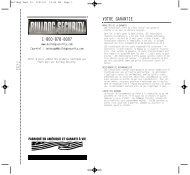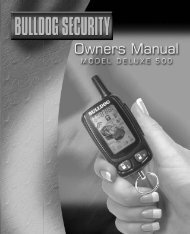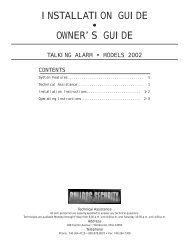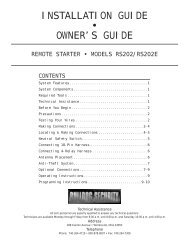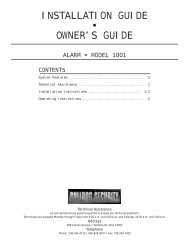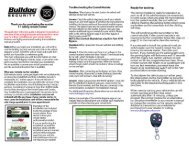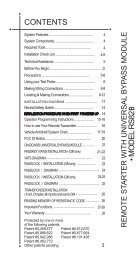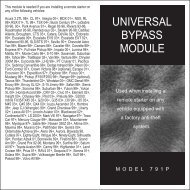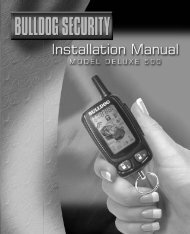You also want an ePaper? Increase the reach of your titles
YUMPU automatically turns print PDFs into web optimized ePapers that Google loves.
CONTENTSSystem Features ...............................................4-5System Components.............................................6Required Tools.....................................................6Technical Assistance .............................................6Before You Begin...............................................6-7Precautions ......................................................7-8Testing Your Wires ...............................................8Making Connections .........................................8-10SYSTEM FEATURES2 Four-Button Control your car from an extendedExtended Range distance.Remote ControlKeyless EntryRemote Lockingand Unlockingwith IgnitionSwitchRemote ValetRemotely locks and unlocks your powerdoor locks.Remotely locks your power door lockswhen the ignition is turned on and unlocksyour power door locks when the ignitionis turned off. NOTE: This feature can alsobe used while the unit is wired as analarm.Lets you program off the alarm sectionwhen it is not needed.Remote Full Time This system will perform all its functionsSilent Arming except no chirping when arming ordisarming the system.‘Locating & Making Connections .........................10-18Connecting Wiring Harness ...................................18Testing Door Locks .........................................18-19Connecting Door Locks ....................................20-21Using Your Remote Transmitter.........................22-263RemotelyProgrammablePassive ArmingLast DoorIndicatorProgrammableAutomaticAnnoyanceAutomatically arms the system oneminute after the last door is closed.When the last door is closed, a series ofbeeps or chirps (long, short, long) willbe heard when the unit is programmedfor passive arming.If the same zone is violated three timeswhile the system is armed, that Overridezone will be deactivated until the unit isdisarmed and rearmed.4
‘ ‘SYSTEM FEATURES CONT.SYSTEM COMPONENTSOn-Board Built-in relay provides a positive (+)Parkingparking light output. No relay needed.Light RelayOn-Board DoorLock RelayBuilt-in relay for Type A, Type B andType C door locks.Plug In Six A visual theft deterrent that flashes whenFunction LED the system is armed. Lets you knowStatus Indicator which zone has been violated, andand provides a visual reference for you.E SquareMemory BackupCode LearningStarterImmobilizerDome LightSupervisionTwo AccessoryOutputsThe system will memorize its programmedfeatures in the event that the power islost.Allows your keyless/alarm to learn newremotes, should you want to add remotes,or if remotes are lost.Prevents a thief from starting your vehiclewhen your system is armed. (Optionalpart #775 required)Illuminates the vehicles interior lightswhen the remote transmitter unlock/disarm button is pressed. (Optionalpart #775 required)Use for trunk release, power windowroll up, etc. (Optional part #775 requiredfor all options)Your system includes:1-Installation & Operation Guide1-Main Control Module2-Four Button Remote Transmitters1-11-Pin HarnessREQUIRED TOOLSTECHNICAL ASSISTANCEShould you need help. First check our website atwww.bulldogsecurity.com or call our toll-free Tech SupportHotline Monday through Friday 9AM-8PM and Saturday 10AM-4PM EST at 800-878-8007.You must give the following information:•Name• Telephone Number with Area Code (Fax number if applicable)BEFORE YOU BEGIN1-5-Pin Harness1-Momentary Switch1-LED Status Indicatorand Bracket1-WarrantyYou will need a computer-friendly test light and a 5/16 drill bitwhen mounting the hood pin switch. In most cases no additionaltools are required, however if the bottom of your dash on thedriver’s side will come off you must remove it. In this case ascrewdriver or socket set may be needed.Congratulations, you have purchased one of the most advancedalarm systems ever made. Your new system is a technologicalbreakthrough utilizing the most advanced, state of the artLimited Lifetime Guarantees life-long protection.Warranty56
BEFORE YOU BEGIN CONT.technology and components. It is computer controlled andmanufactured in the U.S.A. The dependability and variety offeatures make <strong>Bulldog</strong> <strong>Security</strong> the leader in the industry. Enjoyyour new system for years to come!Since there are many different makes and models of vehicles,look at the wiring chart on our website,www.bulldogsecurity.com/wires.htm.Read this manual thoroughly before starting the installation.PRECAUTIONSThis system will add remote keyless entry features to any vehiclewith power door locks. This will also work as a replacementsystem for the factory installed keyless entry system.Use masking tape to indicate the preferred mounting locationsof interior components, LED and override switch.Disconnect the dome light fuse until you are ready to plug theunit in.DO NOT use mechanical wiring connections, such as crimp orsnap together taps. Follow instructions on pages 2-3.DO NOT disconnect the battery if the vehicle has an anti-theftcodedradio or is equipped with an airbag. Doing so may causea warning light to be displayed and may require a trip to thedealer to be corrected.DO NOT leave the interior or exterior lights on for an extendedperiod of time as it may cause battery drain.DO NOT mount the control module until all connections havebeen made and tested. Using wire ties or double sided tape,MOUNT THE MODULE UNDER THE DASH.7PRECAUTIONS CONT.DO NOT plug the harnesses into the control module until allconnections have been made. Be careful to line up the pins onthe unit with the wiring harness plug (lip up - Red wire to theright). Failure to do this will cause severe damage to the unitand possibly to the vehicle.TESTING YOUR WIRESWhen testing for a positive or negative voltage, you must use acomputer friendly test light (logic probe) or a volt/ohm meter. Makesure to probe and test each wire before making your connections.MAKING CONNECTIONSNOTE:If it is necessary to cut a factory wire to make a connection,see diagram on page 8.1. Strip back two inches of insulation on the wire from the remotestarter.Two Inches of Bare Wire2. Strip back one inch of insulation on the wire you need to connect to.One Inch of Bare Wire3. Separate the vehicle wire as shown. Make the separation largeenough to fit the other wire through.4. Insert the wire(s) from the starter through the hole as shown. if twoor more wires are inserted, wrap them in opposite directions.8‘
MAKING CONNECTIONS CONT.5. Wrap the wire around one side then the other and finally arounditself as shown.2 13MAKING CONNECTIONS CONT.3. Lay upper twisted pair of wiresover right wire as shown. Bringlower twisted pair of wires upto meet the left wire as shown.‘6. Use electrical tape to wrap. Be sure to cover the wire about twoinches on either side of the connection. First pull the wire that youhave just connected along side the wire you connected to, tape andwire tie them together. Use this method for all connections.Wire TieElectrical TapeCAUTION: All wires must be wrapped with tape and wiretied.MAKING END TO END CONNECTIONSFOLLOW THESE INSTRUCTIONS1. When tying two separate wires together at their ends, strip back 1”of insulation on both wires and separate the strands of wire as shownbelow.2. Twist upper wires together, twist lower wires together as shown.94. Use electrical tape to wrap, be sure to cover about 2 inches on eitherside of connection. Secure with wire ties as shown.Electrical TapeWire TiesUse this method ONLY when connecting two separate wires end to end.LOCATING & MAKINGCONNECTIONSCONSTANT POWER (+12V, key in any position including off)This system operates on constant 12 volts, the system also needs a sourceof power that is only on when the ignition is turned on (usually referredto as “Ignition Power”.1. Locate the wires going to your vehicle’s ignition switch (usually locatedcoming down the steering column). When looking for constant 12 volts:Usually a large gauge wire located at the ignition switch harness. Probethese wires until you find one that turns a “computer-friendly” test light,or shows 12 volts when the ignition switch is turned to the ON, OFF,START and ACCESSORY positions. If this wire cannot be located at theignition switch harness, run at least a 16 gauge wire from the positivebattery terminal fused at 6 inches from the positive battery post to theinside of the vehicle through the firewall. (Additional hardware is needed.)2. Mark this with its function “Constant Power”.10
LOCATING & MAKINGCONNECTIONS CONT.3. Turn the ignition ON. Probe for a wire that shows 12 volts only when theignition is on. Confirm this by turning the ignition on and off while probingeach wire.4. Mark this wire with its function “Ignition Power”.5. If these wires cannot be located, please call our technical support staff at800-878-8007.CONNECTING THE POWER AND GROUND1. Connect the RED wire from the harness to a constant 12 volt supply or tothe wire you ran from the positive battery post (if no constant 12 volt supplywas found at the ignition switch harness).2. Connect the BLACK wire from the harness to a clean chassis ground, usuallya steel automotive body part connected to the negative side of the battery.CONNECTING IGNITION POWER1. Connect the YELLOW/BLACK wire from the harness to the wire marketIgnition Power.FINDING THE PARKING LIGHT WIRE (optional - included)To have the parking lights flash when using keyless entry or during a violation,you must connect the <strong>1402</strong> to the vehicle’s parking lights.1. Locate the wire harness coming from the back of your vehicle’s light control.If the control is on your vehicle’s steering column, the harness probably joinsseveral wiring harnesses.2. Use the vehicle’s wiring color code to find the parking light wire. Connectthis wire to the parking light wire usually located under the hood going to yourparking lights.3. Turn on the parking lights. Probe the wires. The test light should lightindicating 12 volts only when the parking lights are on.4. After you locate the wire, use a piece of masking tape to mark it with itsfunction (Parking Lights).CONNECTING THE PARKING LIGHT WIREConnect the BROWN wire from the wiring harness to the wire marked “ParkingLights”.11LOCATING & MAKINGCONNECTIONS CONT.CONNECTING THE NEGATIVEOUTPUT #1, BUTTON #2THE BLUE wire is used to operate aremote car starter, window roll-upmodule, etc. for as long astransmitter Button #2 is depressed.NOTE: A SPST or SPDT relay mustbe used if you want to convertthe negative signal to positiveor if the device you’re controllingdraws more than 200 ma. Ifyou’re not sure how muchOptional Part #775TO FACTORY TRUNKWIRE OR OTHERPOSITIVEACTIVATEDACCESSORYBLUE 87a12 VOLTS CONSTANTamperage is being drawn, add the relay. This negative outputis only rated for 200 ma (1/5 amp). CAUTION: Overloadingthese outputs is not considered a warranty related repair.CONNECTING THE NEGATIVE OUTPUT #2, BUTTON #3The GREY wire is used to operate the power trunk release. Press andrelease Button #3. The trunk will open and the parking lights willflash. If the unit is armed (doors locked) you must press and holdButton #3 for two seconds. The trunk will open and the shock sensorinput (black wire with green tag) will be disabled. The door triggerswill still be active. NOTE: A 30 amp relay must be used since thisnegative output is only rated for 200 ma (1/5 amp). Sincemost power trunk releases are positive controlled and draw5 to 6 amps, this relay handles the load and also can convertthe release signal from negative to positive polarity.INSTALLING THE FLASHING LED STATUS INDICATOR (optional)The LED indicator installs inside your vehicle and should be installedas high as possible and in view from all windows. Drill a 1/4 inchmounting hole in the dash panel or use the supplied mounting bracketto hold the LED status indicator in place.CONNECTING THE LEDWHITESTATUS INDICATOR PLUGPlug the LED Statusindicator into the blue plugbetween the white plugand the main header.OVER-RIDESWITCHBLUE PLUGLEDINDICATOR22 GA BLACK WIRE WITH GREEN TAG(Shock or microwave sensor - negativeGROUND input), optional accessories required‘
LOCATING & MAKINGCONNECTIONS CONT.CONNECTING THE CAR HORN WIREYou must use optional part #775.Back of #775(relay and harness)87WHITE86 87a 85To (+) horn30honk outputwire from unitREDBLACK/BLUENot usedBLUEYELLOW To (-) hornwire in vehicleBLACKLOCATING & MAKINGCONNECTIONS CONT.Using the siren base as a template, mark the three mounting holes.Drill a 1/8 inch hole at each mounting hole location, taking care not todamage anything behind the mounting surface.Secure the siren to the mounting location with two of the mountingscrews.Connect the wires as shown.BLACK/BLUEBLACKRED‘MOUNTING AND CONNECTING THE OPTIONAL SIRENSelect a location under the hood for the siren. For best results, the locationshould meet the following conditions:•The mounting location should be solid and have no moving parts nearby.•For the loudest sound, the siren should point down.•The siren should not point straight up as moisture could collect in thesiren horn and damage the system.•To prevent water damage, the siren should NOT be mounted in a wheelwell, directly behind the radiator grill or close to the ground.•Mount the siren as far away from sources of heat, i.e. exhaust manifold,turbo charger, etc. as possible. Tape, wrap or tube all wires. Run allwires to the siren as high up in the engine compartment as possible toprevent cutting from below.15MOUNTING ANDCONNECTING THEOVERRIDE SWITCHSelect a location for theoverride switch. Youshould be able to reachthe switch when sittingin the driver’s seat, butthe switch should beWHITEPLUGOVER-RIDESWITCHBLUE PLUGLEDINDICATOR22 GA BLACK WIRE WITH GREEN TAG(Shock or microwave sensor - negativeGROUND input), optional accessories requiredhard to find. A typical mounting location is under the dash. Themounting surface should be less than 1/8 inch thick.16
‘ ‘LOCATING & MAKINGLOCATING & MAKINGCONNECTIONS CONT.CONNECTIONS CONT.Drill a 5/16 inch hole in the mounting surface, taking care not to damageanything behind the surface.Remove the switch’s top nut and lock washer.Push the switch into the hole from the back of the mounting surface.Then secure it with the lock washer and nut.Connect the ground wire to a metal vehicle body part using an existingscrew.Plug override switch into the left side of the main header.CONNECTING THE DOME LIGHT SUPERVISION(Optional relay needed,Optional Part #775part #775)Connect the BLACK/WHITEwire from the control modulewiring harness to the relay.(-) BLACK/Connect the relay to theWHITE87a“dome light” wire, normally FROMfound in the driver’s kickMODULEpanel. NOTE: A relay mustbe used to connect the domelight supervision function. (+) OR (-) DEPENDING ONDOOR TYPE NOTE: IF (+),FUSE AT 20 AMPSFollow the instructionsthat come with thesensors to mount andpower them. The systemrequires a negative (-)output from the sensor foractivation of the alarm.Connect negative out fromWHITEPLUGCONNECTING ADDITIONAL SENSORSNOTE: We suggest adding the optional shock sensor model UTB-2 for additional protection.OVER-RIDESWITCHBLUE PLUGTO DOMELIGHTCIRCUIT12V (+)FUSED AT 5AMPSLEDINDICATOR22 GA BLACK WIRE WITH GREEN TAG(Shock or microwave sensor - negativeGROUND input), optional accessories required17sensor to 22 gauge BLACK wire with green tag. If you add more thanone sensor, a diode must also be added. NOTE: This unit is designedto use only a single stage sensor. If you are using a dual stagesensor, use only the major output of the sensor. CAUTION: Whenadding more than one perimeter sensor on the same input trip,you must add a 500ma diode to the output of each sensor.CONNECTINGTHE WIRING HARNESS1. BLUE/BLACK Lock Output2. BLUE/WHITE Lock Input1. YELLOW Antenna2. GREY (-) Ch. 3 Output3. RED/BLACK (+) or (-) Door Pin Input4. BLACK/WHITE (-) Dome Light Output5. BLACK/BLUE (+) Siren OutputDOOR LOCK HARNESS5. GREEN/WHITE Unlock Input4. GREEN/BLACK Unlock Output3. RED/BLACK To source (+) or (-)FUSETESTING DOOR LOCKS6. BLUE (-) Ch. 2 Output11. RED (+)12V ConstantFUSE10. BLACK Ground9. BROWN (+) Parking Light Output8. BLUE/BLACK (-) Starter Immobilizer Output7. YELLOW/BLACK (+) Ignition InputTESTING: Door Locks • There are four basic types:“Type A” Door Lock Test (Most GMs and some Chryslers)Probe both of your door lock wires going to the door lock switch usuallylocated in the driver’s kick panel. Attach the clip end of your test lightto a good chassis ground. Using the vehicle’s door lock controls, activatethe lock then the unlock, testing both wires one at a time. If one of these18
TESTING DOOR LOCKS CONT.CONNECTING DOOR LOCKS CONT.wires tests (+) positive when lock is pressed and the other tests (+)positive when they are unlocked, your vehicle has a “Type A” door“Type A” (+) Positive (5-pin harness)locking system. Make sure to mark which wire is lock and unlock. Proceedto Connecting Door Locks, Connecting Door Locks. NOTE: “Type A” andBLUE/BLACK Lock“Type C” locks will test the same, until you test for ground. Make sureyou run both tests before making your connections.BLUE/WHITE Not Used“Type B” Door Lock Test (Most Imports, some newer Fords)LOCKProbe both of your door lock wires going to the door lock switch usuallylocated in the driver’s kick panel. Attach the clip end of your test lightRED/BLACK+12V Constantto +12V. Using the vehicle’s door lock controls, activate the lock then theFUSEUNLOCKunlock testing both wires one at a time. If the test light illuminates whenyou probe the lock and the unlock wires your vehicle has a “Type B”GREEN/BLACK Unlockdoor locking system. Make sure to mark which wire is lock and unlock.Proceed to Connecting Door Locks.GREEN/WHITE Not Used“Type C” Door Lock Test (Most Fords, some Chryslers, GM Trucks)NOTE: Connect the RED WITH BLACK STRIPE wire to +12V constant power.(Optional part #778 required)Using your test light probe both the lock and the unlock wires usuallylocated in the driver’s kick panel. Attach the clip end of your test light“Type B” (-) Negative (5-pin harness)to ground probing both wires one at a time while locking and unlockingthe doors with the driver’s side switch (usually the master switch). TheBLUE/BLACK Locktest light should illuminate in both switch positions. Now attach the clipend of your test light to +12V constant, probe both wires one at a timeBLUE/WHITE Not Usedagain. The light should then illuminate again only in reverse order. Thistells you that you have a “Type C” reversing polarity system. Make sureLOCKto mark which wire is lock and unlock. Proceed to Connecting Door Locks.RED/BLACKGroundTesting Switch Wire and Motor Wires for” Type C” Door LocksFUSEBefore connecting, you must now determine which wire is the switch wireUNLOCKand which is the motor wire. Cut both the lock and unlock wires in half.GREEN/BLACK UnlockStart with both of the lock wires by placing the clip end of your test lightto ground, hold the door lock switch in the lock position, make sure youare using the master switch (usually on the driver’s door) and probe bothGREEN/WHITE Not Usedlock wires looking for voltage. The wire that illuminates the test light,NOTE: Connect the RED WITH BLACK STRIPE wire to ground.mark as the switch wire, the wire that shows no voltage, mark as themotor wire. Repeat the procedure for the unlock wire.One Wire Door Lock SystemSome vehicles have a single switch wire for both lock and unlock. Thissystem will wire as a “Type A” or “Type B” depending on the vehicle. Theonly difference being this system will require one or two resistors dependingon the make and model of the vehicle. Please consult our website for theproper resistor value for your vehicle. 1920MODULEMODULE‘
CONNECTING DOOR LOCKS CONT.“Type C” Reverse Polarity (5-pin harness)MODULEOne Wire Door Lock System (Example is for Chrysler)DOOR LOCK PLUGBLUE/BLACK LockBLUE/WHITE LockRED/BLACKBLUE/BLACK Lock OutputBLUE/WHITE Not UsedRED/BLACKFUSEGREEN/BLACK UnlockGREEN/WHITE UnlockFUSEGREEN/BLACK Unlock OutputGREEN/WHITE Not Used+12V ConstantNOTE: Connect the RED WITH BLACK STRIPEwire to +12V constant power.NOTE: You will need to cut factory wiring to make an endto end connection, see “Making Connections” on pages 2-4.620 OHM resistor tounlock, must be 5%tolerance.+12V Constant2700 OHM resistorto lock, must be 5%tolerance.NOTE: Connect the RED WITH BLACK STRIPEwire to +12V constant power.POWERDOORLOCKMOTORUNLOCKLOCKThis is a one (1)wire door lockingsystem and willrequire two (2)resistors to lockand unlock thedoors. Locate theWHITE/DKGREEN wire inthe driver’s kickpanel. This wirecontrols the doorlocks. Add theresistors asstated in thediagram. Wirethe unit in as a“Type A” system.21HOW TO USE YOURREMOTE TRANSMITTERBUTTON #1ARM/DISARMBUTTON #3OPTION #3*BULLDOGBUTTON #2OPTION #2BUTTON #4KEYLESS ENTRYFUNCTIONSLOCKING DOORSPress transmitter Button #1to lock the doors. Theparking lights will flash onceand the horn or siren willsound acknowledging theunit received the signal.UNLOCKING DOORSPressing transmitter Button #1 again will unlock the doors. The parking lightswill flash twice and then stay on for approximately 30 seconds and the hornor siren will sound twice acknowledging the unit received the signal. NOTE:If dome light feature is installed, the dome light will come on and stay on for30 seconds.LOCKING AND UNLOCKING WITH IGNITION SWITCHSee keyless entry programming options. NOTE: If your vehicle already hasthis option, (Factory Installed) do not activate.FULL TIME SILENT KEYLSS ENTRYThis will eliminate the horn or siren from sounding when locking or unlockingyour doors (See Silent Arming & Disarming in Alarm Programming Options).ARMINGPress Button #1 to arm the system. The siren will chirp once, the lights willflash once, the power door locks will lock and the LED will flash slowly toindicate that the system is now armed. The engine starter is also disabled.DISARMINGPress Button #1 while the system is armed and the system will be disarmed.The siren will chirp twice, the lights will flash twice (and stay on for 30 seconds)showing that the system is disarmed. If you hear three (3) siren chirps andsee three (3) light flashed when disarming, the vehicle was violated while youwere away. The LED will flash the zone violation (see page 23). When disarming,the dome light will turn on for 30 seconds.SILENT ARMING/DISARMINGPress and hold Button #1 to arm, but continue to hold the button. After three(3) seconds, the system will perform all arming functions as described above.except there will be no chirps (for this arming period only).22‘
‘ ‘HOW TO USE YOURHOW TO USE YOURREMOTE TRANSMITTER CONT. REMOTE TRANSMITTER CONT.DUAL LOCK/UNLOCK PULSETo program the Dual Lock/Unlock Pulse, press Button #3 for ten (10) seconds.The system will chirp once. Press Button #4 within two (2) seconds and thesystem will chirp once again to signify that the dual unlock pulse is programmed.The above steps must be repeated to program dual pulse lock (2 chirps), bothdual pulse lock and unlock (3 chirps), then no dual pulse functions (4 chirps).PROGRAMMING A NEW TRANISMITTER (up to 4 remotes allowed)Press and hold Button #1 for ten (10) seconds while the system is disarmed.The system will flash the arm flashes and will chirp once after the ten (10)second period. Immediately press a button on the new and the parking lightswill flash twice.HORN/SIREN FUNCTIONALITYTo program the Horn/Siren Functionality, press and hold Button #4 for ten(10) seconds. The system will chirp once. Press Button #3 within two (2)seconds and the system will chirp once again signifying that the horn outputis selected. To program the siren output, follow the above steps, and two (2)chirps will be heard after pressing Button #3, signifying that the siren outputis selected.DOOR PIN POLARITY PROGRAMMINGPress and hold Button #4 for approximate ten seconds or until the unit chirpsonce. Release Button #4 and press and release Button #1. If the unit chirpsonce the module is programmed for a (+) positive door pin input. If the unitchirps twice then it is programmed for a (-) negative. If you need to go backand program for one or the other, you must start from the beginning.CLEARING THE E-PROM MEMORYTake the BLACK wire with the green tag and attach it to a chassis ground(shock or microwave sensor input) white plug with the override switch. Thencycle the ignition key from “off” to “run” six times within five seconds. TheYELLOW WITH BLACK STRIPE ignition wire must be hooked up. Finally, unplugthe 11-pin harness, wait one minute then plug it back in. Press any buttonon the remote transmitter.KEEP THIS MANUAL IN YOURGLOVEBOX TO USE AS A REFERENCE.25CLEARING THE E-PROM MEMORYTake the BLACK wire with the green tag and attach it to a chassis ground(shock or microwave sensor input) white plug with the override switch. Thencycle the ignition key from “off” to “run” six times within five seconds. TheYELLOW WITH BLACK STRIPE ignition wire must be hooked up. Finally, unplugthe 11-pin harness, wait one minute then plug it back in. Press any buttonon the remote transmitter.KEEP THIS MANUAL IN YOURGLOVEBOX TO USE AS A REFERENCE.26
YOUR WARRANTYHere's how your warranty works:JBS Technologies warrants to the original customer, and the original car a limitedlifetime warranty.Within 12 months of purchase, JBS Technologies will repair or replace, our option, anydefective system at no charge. After 12 months from date of purchase JBS Technologieswill, at our option, repair or replace the system for a $10 shipping and handling fee.Installation, labor, removal and reinstallation are not the responsibility of JBSTechnologies. Registration must be completed and sent in within seven (7) days ofpurchase in order to validate the warranty. JBS Technologies makes no warrantyagainst the theft of a vehicle or its contents. This warranty is not to be construed asan insurance policy against loss.DISCLAIMERJBS Technologies disclaims the warranty of merchantability and fitness for any particularuse. This disclaimer shall be effective as to all claims of any kind made by or throughany wholesaler, retailer, consumer or any other person or entity. Some states do notpermit the disclaimer of implied warranties in some sales. Hence, this disclaimer maynot apply to you.LIMITATION OF REMEDIESConsumer's remedy is limited to repair or replacement of the unit, and in no eventshall exceed the purchase price. Incidental, consequential an/or indirect damages areexpressly disclaimed. NO person or entity is authorized to alter, amend or increasethis limited warranty.FILL OUT THIS FORM AND MAIL IT IN TO REGISTER YOUR WARRANTYYour Name ________________________________________Address __________________________________________________________________________________Email Address ____________________________________Dealer Name _____________________________________Address __________________________________________________________________________________Date of Purchase ____/____/____ <strong>Model</strong> # <strong>1402</strong>Make/<strong>Model</strong> of Car ________________________________Year of Car _____ V.I.N. # _________________________Mail to: JBS Technologies225 Technology Way • Steubenville, Ohio 43952Creating A Higher StandardJBS Technologies, LLC225 Technology WaySteubenville, OH 43952Toll Free: 800.878.8007Fax: 740.282.1201www.bulldogsecurity.comemail:techsupp@bulldogsecurity.comJBS Technologiesproduces the world'smost innovative andreliable car alarms,remote starters,keyless entrysystems and starterimmobilizers.JBS Technologies isnot an importing ordistribution company.Our products aredesigned andproduced in the U.S.A.High quality controland space-agerobotics insureflawless performanceof every unit.Look for our productsand services on theworld wide web or callour highly trainedsupport staff toprovide assistance toget you on your wayto a safer, moreconvenient drivingexperience.‘



